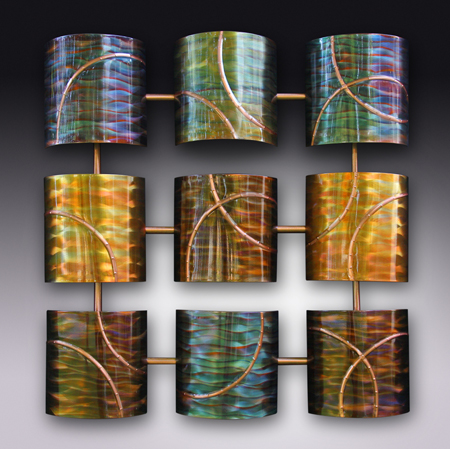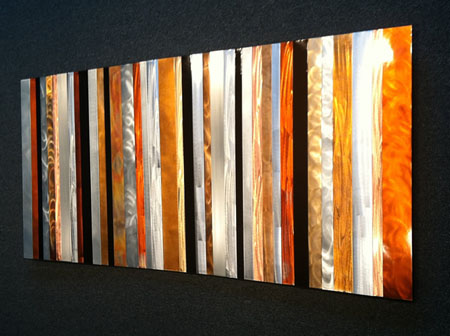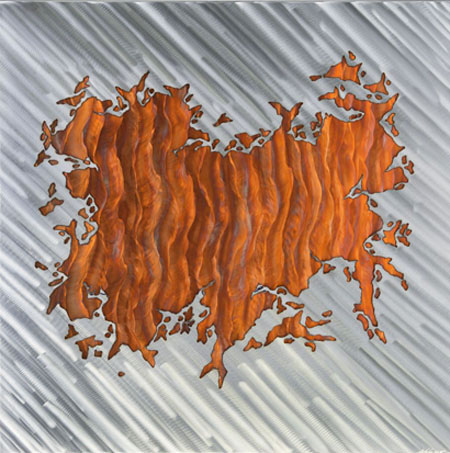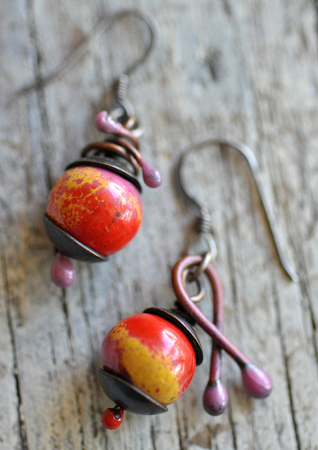Torching Stories Told Through Copper
Like a paintbrush of fire, taking a torch to copper, brass and bronze stretches gems of vibrant yet humble hues across the warmth of these metals.
Nicholas Yust has been doing this since 2007, inspired by a project with steel and plastic as a civilian employee at Wright-Patterson Air Force Base in Dayton, Ohio.
 Nine torched sections of metal and tubing finalized by Dan and Frances Hedblom.
Nine torched sections of metal and tubing finalized by Dan and Frances Hedblom.Photo courtesy of Dan and Frances Hedblom.
“We needed to enhance the cosmetic details of an electromagnetic polishing fixture,” Yust says.
This work soon lead to sideline experimentation of texturing metals, and several torches eventually became his close companions.
Yust uses air-powered die and angle grinders, sanders and electric grinders, in addition to his torches, along with either water-based or urethane paints to manipulate pigments.
“I combine the flow of the grind patterns with the heat of the torch,” Yust says. “This allows the colors to overlap and work in union with the texture of the grind. I also have some tricks which incorporate water and different alcohols to manipulate the heat flow.”
His torching temperature range is generally between 3,000° to 6,000° Fahrenheit.
 Striations by Nicholas Yust incorporates bronze, copper and aluminum materials. A glossy, automotive clear-coat spans the surface.
Striations by Nicholas Yust incorporates bronze, copper and aluminum materials. A glossy, automotive clear-coat spans the surface.Photograph courtesy of Nicholas Yust.
“It is vibrant and iridescent with a feeling of energy, very different than any type of paint could produce,” Yust says. “If you could imagine capturing the colors and energy expelled by a beautiful fire, that is essentially what you see.”
At his exhibitions, viewers sometimes comment that his work resembles abstract seascapes.
“They’ll say it looks like a distant photograph of the ocean,” he says. “A lot of people will see different things. I’ll have a piece at a show, and somebody says they see a fish swimming, and somebody else will say it looks like the Milky Way Galaxy. People associate the art with different natural phenomena.”
In his mind, Yust is always combining the abstraction of his own art with his understanding of the sciences.
 Heart Strings by Nicholas Yust is plasma-cut, ground and colored stainless steel, revealing a ground and torched copper back panel.
Heart Strings by Nicholas Yust is plasma-cut, ground and colored stainless steel, revealing a ground and torched copper back panel.Photograph courtesy of Nicholas Yust.
“Because of my background in engineering, physics, chemistry and mathematics, I have natural visions of energy transformation."
It helps that he has varying visions of how energy can exist in the world.
“I like best how the oxide color and grind texture work together,” Yust adds about the character and capabilities of heat-tinting with copper and bronze. “I have some control of the color distribution, but the physics of the heat transfer through the texture creates some amazing organic color patterns.”
Dan and Frances Hedblom left behind jobs in carpentry and medical coding for pathology to instead grow their Minnesota-based business called Copper Elements.
Frances, who had to start using her paid time-off days at the Mayo Clinic to do her copper torching work before finally going full-time with her artistry, labored in high heels after full shifts at the office, her husband Dan explains.
Now she dresses more comfortably and the demand for her work since opening in 2010 has only increased.
Dan cuts pine wood to fit as curved, solid bases behind their wall displays in copper, and he handles final oven-baking efforts and finalization in their workload, knowing Frances is the true torch artist between them.
 Pink and yellow-speckled earrings made with brass with enamel, by Barbara Lewis.
Pink and yellow-speckled earrings made with brass with enamel, by Barbara Lewis.Photograph courtesy of Barbara Lewis
"My father was a pipefitter his whole life so he was with me when I bought my first torch," Frances says. "He showed me how to use it, how to turn it on, how to clean the tip periodically."
And when Frances is torching, she only works with the oxygen and propane in her tank—no paint, stains or other chemicals.
In the beginning, Dan and Frances could only work with pieces which were no more than 36 inches in size. But thanks to custom-built equipment and moving from their home studio space to a 2,500-square-foot warehouse, they are now creating torched copper as larges as six feet tall.
Their more discernible themes through torching are oceans, lakes, waterfalls and trees.
And their customers know the value of these reminders of the natural world in our busy, technology-driven, and hectic lives.
“They love the brilliance and warmth of the colors,” Dan notes. “Customers say the pieces are calming. One woman put our art her massage room.”
Continuing success and diving more into the art world and away from modern trades translated to opening the Gallery on First below the Marriott in downtown Rochester one year ago.
The underground gallery run by the Hedbloms features not only their own art but works by other artists, too, including most recently fellow copper enthusiast Houston Llew of Atlanta.
Barbara Lewis opened Painting with Fire in the art-hugging community of St. Petersburg, Florida, in 2009.
As a former potter, a shoulder injury meant she needed to steer her talents in another direction using lighter weight materials.
Through her business today, she teaches a curious array of jewelry-making approaches, including torch-fired enameling on different metals. And she certifies instructors around the country to teach from her equipment and techniques.
In the early days of her craft, she realized the Internet only offered limited resources on how to do this kind of enameling. So she eventually wrote two books on the subject, released by one of the top craft instruction publishing companies in the country, North Light Books.
When Lewis works with copper, brass and other metals, she sometimes shapes it ahead of time, like in the case of sky-reaching flower petals.
And since she easily encourages torch-fired enameling through varied kinds of glass in small forms but to the masses as well as those who visit her studio, she does instructional videos, too.
“I use a hot-head torch and have found it to be very reliable,” she says, working between 1,500° and 1,600° Fahrenheit. “And I also use a lampworking torch.”
Lewis decided to use torches for her beads because she says she wanted to get different effects compared to anything more expected.
“If you over-fire enamel, and it’s on copper, for instance, copper oxides will bubble up to the surface,” Lewis explains. “And when they reach the surface, they will look like little green freckles. If you bring a piece of metal closer to the dirty part of the flame, those will become pink flashes of color.”
Lewis also notes that over-firing results in enamel pulling away from the edges so that a crispy brown frame borders the metal; copper oxides bubbling up through the enamel mid-firing then whisk a textured pattern into a bead.
She has a mix of local students as well as ones who visit her neighborhood to take a learning vacation.
One aspect which her students enjoy is how it’s a much quicker process than creating beads other ways and especially through lampworking.
“The thing about torch-fired enameling is that it’s very fast,” Lewis says. “A lot of lampworkers are very attracted to this because it’s faster and more affordable and also lighter. Enamel on metal is very lightweight.”
Lewis can dredge a bead into a specific eye-alluring blend with enameling powder, then completing its torch-firing in 42 seconds.
“I might spend three minutes on a bead, at the most,” she adds about her torch-firing—which she loves for how she can watch the process directly without ever having to use a kiln.
Resources:
Also in this Issue:
- Torching Stories Told Through Copper
- Fabitecture: Nature’s Beauty Mark on Copper
- Koja Designs: Using Copper as a Canvas
- Recycling Mixed Metals to Create Beautiful, Unique Artwork
- French Sculptor Auguste Rodin Celebrated throughout North America and beyond with Rodin100 Tour
